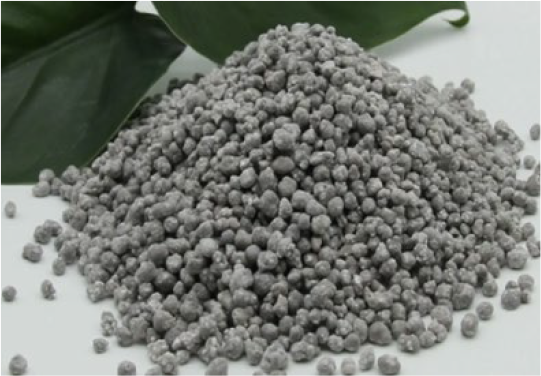⇦ Back to Fertilizer Lime Amendment Technology and Use Home
¶ Introduction
Single superphosphate (SSP) was the first commercial mineral fertilizer and it led to the development of the modern plant nutrient industry. This material was once the most commonly used fertilizer, but other phosphorus (P) fertilizers have largely replaced single superphosphate because of its relatively low phosphorus content
¶ Table 1. |
|
| Analysis | 16% - 20% P2O5 |
| 11% - 12% S | |
| 18% - 21% Ca | |
| Chemical formula | Ca(H2PO4)2 |
| pH (1% solution) | < 2 |
| Bulk density, lbs./cu.ft. | 58 - 60 |
¶ Production
The modern fertilizer industry was launched in the 1840’s with discovery that the addition of sulfuric acid to naturally occurring phosphate produced an excellent soluble fertilizer, given the name superphosphate. Ground animal bones were first used in this reaction, but natural deposits of rock phosphate (apatite, Ca3(PO4)2) soon replaced the limited supply of bones.
Making single superphosphate is similar to what naturally occurs with bones or apatite in acid soils. The basic technique has changed very little in the past century. Ground phosphate rock is reacted with sulfuric acid to form a semi-solid which cools for several hours in a den.
The plastic-like material is then conveyed to a storage pile for several weeks of additional curing. The hardened material is then milled and screened to the appropriate particle size or granulated. The general chemical reaction is:
Ca3(PO4)2 + 2H2SO4 → Ca(H2PO4)2 + 2CaSO4
rock phosphate + sulfuric acid → monocalcium phosphate + gypsum
Single superphosphate can easily be produced on a small scale to meet regional needs. Since single superphosphate contains both monocalcium phosphate (MCP, also called “calcium dihydrogen phosphate”) and gypsum, there are no issues with phosphogypsum by-product disposal as occurs with the manufacture of other common phosphorus fertilizers.
Single superphosphate is also known as “ordinary superphosphate” and “normal superphosphate”. It is sometimes confused with triple superphosphate (TSP) production, which is made by reacting rock phosphate with phosphoric acid.
¶ Agricultural Use
Single superphosphate is an excellent source of three plant nutrients. The phosphorus component reacts in soil similarly to other soluble fertilizers. The presence of both phosphorus and sulfur (S) in single superphosphate can be an agronomic advantage where both of these nutrients are deficient.
In agronomic studies where single superphosphate is demonstrated to be superior to other phosphorus fertilizers, it is usually due to the sulfur and/or calcium that it contains. When locally available, single superphosphate has found wide-spread use for fertilizing pastures where both phosphorus and sulfur are needed.
As a source of phosphorus alone, single superphosphate often costs more than other more concentrated fertilizers, therefore it has declined in popularity.
¶ Figure 1. Single Superphosphate (SSP) Form

¶ Management Practices
No special agronomic or handling precautions are required for single superphosphate. Its agronomic effectiveness is similar to other dry or liquid phosphate fertilizers. The loss of phosphorus in surface runoff from fertilized fields can contribute to water quality problems. Farm practices that minimize this loss should be implemented.
¶ Non-Agricultural Uses
Single superphosphate is primarily used as a crop nutrient source. Monocalcium phosphate and gypsum (the two primary ingredients in single superphosphate) are widely used in many products.
Monocalcium phosphate is commonly added to enrich animal feed. It is also routinely used as a leavening agent to cause baked goods to rise. Gypsum is widely used in the construction industry, as well as in food and pharmaceuticals.
¶ References
IPNI. Nutrient Source Specifics No. 21: Single Superphosphate. International Plant Nutrition Institute, Norcross Georgia. 1 pg.